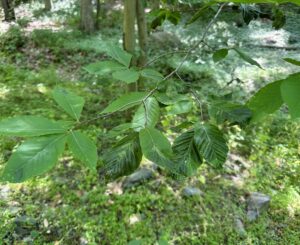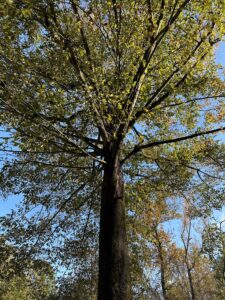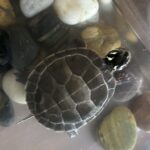Hello, fellow readers. Leaves are well on their way in their fall shift, but many have dropped dry, never changing color. Likely due to the spring draught followed by our wet summer. Tired leaves fall early. At the same time, many are still green, giving us hope for glorious fall colors to come. Speaking of leaves, I am worried about our native American Beech trees being infected with Beech Leaf Disease. It’s also a serious threat to ornamental European Beech.

Early Beach Leaf Disease
About Beech Leaf Disease
While much is a mystery about the disease and research is underway for effective treatment, Beach Leaf Disease (BLD) is caused by a foliar nematode. Nematodes are microscopic worms, not visible to the naked eye. We don’t know where they came from or how they spread so quickly, but they think birds are likely involved in transporting the nematodes.
Found first in Ohio in 2012, according to the University of Rhode Island’s 2023 report on the progression of the disease, it’s now in twelve states and Ontario, Canada. The report shares fertilization strategies to treat Beech Leaf Disease using a phosphate product known as Polly phosphite 30. The results are encouraging (link below).
While the nematode can’t directly kill a tree, impacting the leaves’ ability to photosynthesize weakens and can ultimately cause the beech tree to die. Researchers in Ohio observe trees passing six to ten years after infection. Younger trees, with fewer leaves, are impacted more quickly.
It starts on a few leaves, creating dark bands between its leaf veins. As the disease progresses, more leaves become affected, the dark bands become darker, the leaves look leathery, and the edges brown and curl.
Losing our American Beech would be devastating.
American Beech trees (Fagus grandifolia) host 100 species of butterflies and moths. Their high protein seeds, protected by prickly three-winged beechnuts, are essential food for black bears, turkeys, rodents, raccoons, and deer, though the trees are deer resistant. They are one of the few trees that can thrive in the deep shade of the forest. So, the thought of losing them is devastating.
In a previous story (Beloved Beech Trees), I shared how much I adore Mr. Beech –the glorious tree gracing the front of our home and providing shade during the intense summer sun. I love viewing it from my bedroom window each morning. He contracted Beach Leaf Disease, which has spread aggressively this season. Many of the young trees in the woods are infected, too. We can’t help but think how the emerald ash borer decimated our Ash Trees. Will our beloved beech trees have the same fate?

Mr. Beech Fall 2023
“You’re strong and have proven endurance” to survive Beech Leaf Disease.
I hug Mr. Beech and tell him you’ll be okay. You’re strong and have proven endurance. And you’ll ride this out as you did last Fall when a vast limb came tumbling down. It saddened me because it fell after we pruned the branches overcoming the roof. And so I believe the tree had to regain balance and drop that colossal branch.
Typically, Mr. Beech, as do all native American Beech, holds onto many leaves during winter that turn golden brown. I enjoy the dance in the wind in the winter from my window. So I ask myself, once the diseased leaves drop to the ground, should I gather them, bag them up, and put them in the regular trash to prevent spread? Or is it a hopeless cause?
BLD nematodes overwinter in the buds of the leaves to come. And when the new leaves emerge, while they won’t have symptoms of the disease, they will be paler than healthy leaves. So, perhaps picking up the leaves is irrelevant because they overwinter in the buds. However, the National Park Service writes that the nematodes “occasionally overwinter in leaf litter.”
As I look around the forest where Ash Trees have fallen, new trees are colonizing, benefiting from the nutrients of the fallen trees and leaves before them. So you see, the cycle of life never really ends; it continues, which gives us hope.
Let us never give up hope.
I’ll pick up the diseased leaves.
Garden Dilemmas? AskMaryStone@gmail.com and your favorite Podcast App.

Myrna’s Painted Turtle
There’s much more in the Garden Dilemmas Podcast, including a story about a beloved Pet Painted Turtle and her lovable owner at the Karen Ann Quinlan Home for Hospice, who lifted our hearts.
Related Stories and Helpful Links:
Rhode Island University’s Beech Leaf Disease 2023 Update and Beech Leaf Disease Treatment – June 2, 2022



Another beautiful column/podcast. It brought back warm memories of our time with Myrna. Your columns are always inspirational and uplifting and the description of the cycle of life as regards a leaf was especially meaningful. Thank you so much for sharing your thoughts with us. It is a wonderful way to start the new week.
Thank you, Ken, Our time together each week at the Home for Hospice brings meaning to life. I cherish the time. Thank you for the gifts of music you graciously give (and for inviting me to pipe in.) And for your kind support of my column and podcast. You are a dear friend, Mary
I had no idea about the beech leaf disease. A few years ago, around the Mediterranean there was a palm tree disease. It killed off many palm trees in Greece.
What will you do with the diseased leaves?
It’s sad how many tree diseases are devastating stands of trees. Perhaps it’s nature’s way of reducing populations. Maybe I should let go and let Beech Leaf Disease run its course, but somehow, doing something, like collecting the leaves, helps my heart. I plan to throw them in the regular trash. It is not ideal to add to landfills, but the nematodes won’t have anything to feed on there. Thanks for reading my column, Mary